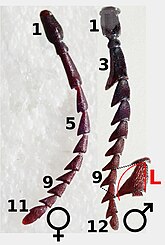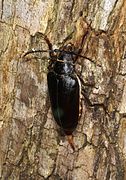Sawhorse (beetle)
| sawhorse | ||||||||||||
|---|---|---|---|---|---|---|---|---|---|---|---|---|

Sawhorse ( Prionus coriarius ) |
||||||||||||
| Systematics | ||||||||||||
|
||||||||||||
| Scientific name | ||||||||||||
| Prionus coriarius | ||||||||||||
| ( Linnaeus , 1758) |
The sawhorse ( Prionus coriarius ) or gerberbock is a species of the longhorn beetle family (Cerambycidae).
Properties of the beetle
Sawhorses are 18 to 45 millimeters long. The slightly shiny chitin armor is brown to black-brown in color. There are three rather weakly developed longitudinal grooves on each wing . The pronotum has three distinct teeth on each side, while there is a fringe of yellow hair on both the front and rear edges. Striking are the long and very strong antennae , which are very strong in the male, slightly weaker and thinner in the female.
Differentiated from Mesoprionus besikanus
In Southeastern Europe the distribution areas of the sawhorse Prionus coriarius and Mesoprionus besikanus overlap . They are easy to mix up. That is why the most important distinguishing features are summarized in Fig. 1 to 3.
In the sawhorse the males have antennae of 12 limbs, the antennae of the females have only eleven limbs, whereby the last limb is quite long (Fig. 1 left and middle). In Mesoprionus besikanus the antennae are twelve-membered in both sexes. The last third of the antennae in the sawhorse are wider than long, in Mesoprionus besikanus they are longer than wide (Fig. 1, the two sections in the middle and right)
On the pronotum , the front tooth of the sawhorse is less pointed than that of Mesoprionus besicanus , the second tooth is less protruding and slightly more curved back, the posterior corner is less sharp than that of Mesoprionus besicanus (Fig. 2).
The third phalanx is broadly bilobed on all legs of the sawhorse, whereas in Mesoprionus besikanus the lobes of the third phalanx are pointed on the hind legs (Fig. 3).
biology
The beetles are quite widespread in Central Europe . They inhabit old trees in deciduous forests, sometimes in avenues.
The nocturnal animals are solitary animals that do not eat any food during their life as beetles. At night they fly to the light where they can be seen most often. By rubbing the hind legs and wing covers together, they can create chirping sounds. The larvae , which can be up to six centimeters long, live under the bark of deciduous trees , more rarely conifers , when they are younger , where they feed on wood. When they have reached a certain age, they move to the root wood. They pupate after three years and a total of fourteen molts. The finished beetle hatches from the pupa.
literature
- Karl Wilhelm Harde , František Severa: The Kosmos Käferführer. The Central European Beetles , Franckh-Kosmos Verlags-GmbH & Co, Stuttgart 2000, ISBN 3-440-06959-1 .
Individual evidence
- ↑ BE Jakowleff: Révision of espèces du genre Prionus de la Faune de la Russie in Horae Societatis Entomologicae Rossicae band XXI, Petropoli 1887 S. 321-340 key Prionus and drawing card IX, 10 and 14th






